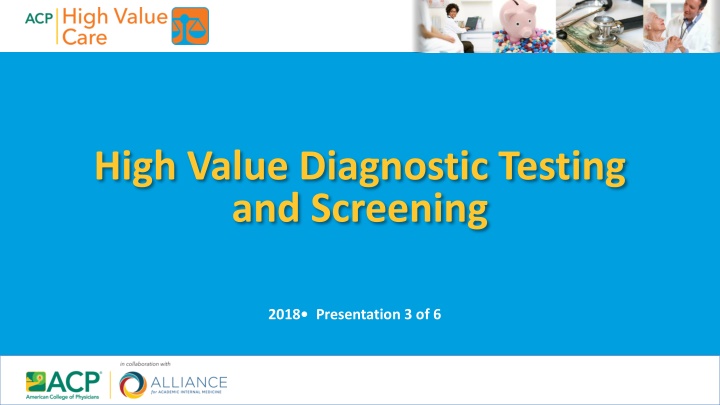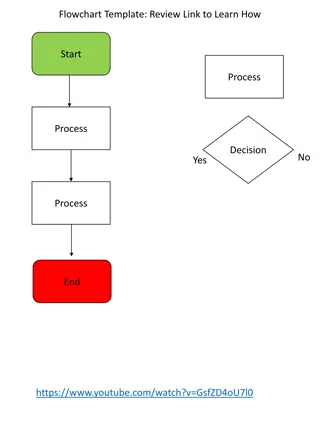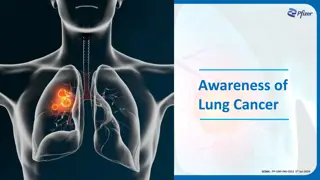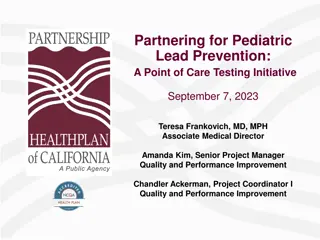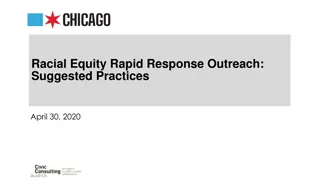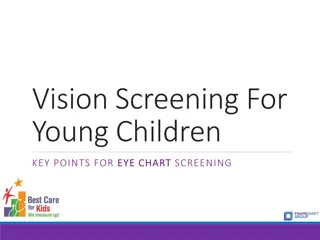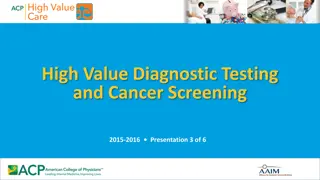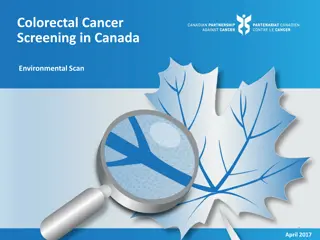High Value Diagnostic Testing and Screening
Review concepts of sensitivity, specificity, and predictive value in healthcare decision-making. Explore benefits, harms, and customization of screening recommendations. Biostatistics explanations and case scenario included.
Download Presentation

Please find below an Image/Link to download the presentation.
The content on the website is provided AS IS for your information and personal use only. It may not be sold, licensed, or shared on other websites without obtaining consent from the author.If you encounter any issues during the download, it is possible that the publisher has removed the file from their server.
You are allowed to download the files provided on this website for personal or commercial use, subject to the condition that they are used lawfully. All files are the property of their respective owners.
The content on the website is provided AS IS for your information and personal use only. It may not be sold, licensed, or shared on other websites without obtaining consent from the author.
E N D
Presentation Transcript
High Value Diagnostic Testing and Screening 2018 Presentation 3 of 6
Learning Objectives Review the concepts of sensitivity, specificity, and predictive value and their application to high value care decision-making Practice applying these concepts to support high value care decisions when considering diagnostic and screening tests Explore the benefits and harms (including costs) of routine screening Develop an approach to customize screening recommendations to an individual patient and his/her unique risk factors, values, and concerns
Case: Biostatistics Review You are in charge of your hospital s rapid response team. You are working with the IT team to develop a tool to identify patients with sepsis, who are at high risk for decompensation and transfer to the ICU The IT team asks if you are looking for a sensitive or a specific predictive tool With your small group, define the following terms and decide which features you value for your sepsis tool: Sensitivity, specificity Positive predictive value, negative predictive value
Biostatistics Review: Definitions1 Sensitivity Ability to detect people who have disease Specificity Ability to detect people who do not have disease Positive Predictive Value (PPV) Likelihood that a person with a positive test result truly has disease Negative Predictive Value (NPV) Likelihood that a person with a negative test result truly does not have disease
Biostatistics Review: Definitions Test Cutoff Disease Health True Negative True Positive False Positive False Negative
Biostatistics Review: Definitions Disease Present Disease Absent Test Positive True Positive False Positive Test Negative False Negative True Negative ???? ???????? Sensitivity = ???? ????????+????? ???????? Be sensitive to those who have disease SenSitivity = Screening
Biostatistics Review: Definitions Disease Present Disease Absent Test Positive True Positive False Positive Test Negative False Negative True Negative ???? ???????? Specificity = ???? ????????+????? ???????? Negative people get specific SpeCificity = Confirmation
Biostatistics Review: Definitions Disease Present Disease Absent Test Positive True Positive False Positive Test Negative False Negative True Negative ???? ???????? PPV= ???? ????????+????? ????????
Biostatistics Review: Definitions Disease Present Disease Absent Test Positive True Positive False Positive Test Negative False Negative True Negative ???? ???????? NPV= ???? ????????+????? ????????
Diagnostic Reasoning Process2 Recognized System 1 Patient Presentation Practice Diagnosis Calibration System 2 Unrecognized
Diagnostic Reasoning Process Post test Pretest Probability Diagnostic Test Probability Disease Prevalence Sensitivity, Specificity PPV, NPV
Diagnostic Reasoning Process Role of Diagnostic Testing To reduce uncertainty regarding a specific patient s diagnosis Generally most appropriate for patients you feel have an intermediate (10%-90%) pretest probability of a disease Test characteristics (such as likelihood ratios) should be considered before ordering a test to help determine whether a given test would significantly alter your post test probability and change your management
Diagnostic Reasoning Process Likelihood Ratios (LR): 1. Use the estimated pretest probability of disease as an anchor on the left side of the graph 2. Draw a straight line through the known likelihood ratio, either (+) or (-) 3. Where this line intersects the graph on the right represents the post test probability of disease
Diagnostic Reasoning Process Likelihood ratios for common exam maneuvers and diagnostic tests Homan s sign for DVT LR (+) 1.1 Nuchal rigidity for meningitis LR (+) 3 Fluid wave for ascites LR (+) 5.0 Mammogram for breast cancer LR (+) 8.7 LR (-) 1.4 ST elevation for acute MI LR (+) 11.2 CT head for acute intracranial bleed LR (+) 23.8 LR (-) 0.05 Valgus laxity for MCL injury LR (+) 146.6
Diagnostic Reasoning Process Likelihood Ratio Post test Pretest Probability Diagnostic Test Probability Disease Prevalence Sensitivity, Specificity
Case: Diagnostic Reasoning Break into 3 small groups Each group will work through a different case of a patient with possible heart failure exacerbation Focus on the diagnostic process: Estimate the pretest probability of disease in your patient Evaluate how BNP would influence your post test probability of disease and assess whether this would be helpful in your patient All three groups must answer the question: Is a BNP a high value test for your patient? Why or why not?
High Value Screening Role of Screening Tests: To detect asymptomatic and early-stage disease Should be highly sensitive and highly specific to pick up most cases of true disease and avoid false positives Targeted toward populations with a higher disease prevalence (high positive predictive value) Should be relatively safe and cost-effective Should screen for diseases in which early identification and treatment have been demonstrated to improve clinical outcomes
High Value Screening: Harms Small Group Activity: Discuss the potential harms associated with screening tests Share a story about a patient you believe was harmed from screening
High Value Screening: Harms False positive results Because primary goal of screening = find disease maximize sensitivity at cost of specificity false positives Can lead to incorrect labeling, inconvenience, expense, and physical harm in follow-up tests
High Value Screening: Harms Lead-Time Bias: Make diagnosis of disease but no mortality benefit Length-Time Bias: Overdiagnosis and Pseudo-disease
High Value Screening Screening Cascade4
High Value Screening Value Framework4
Cases: High Value Screening Screening Value Cases Discuss the following screening cases, and use handout to guide your decisions: 45-year-old woman asking about ovarian cancer screening 68-year-old man, up to date on colonoscopy, requesting FOBT screening 70-year-old woman, with ESRD on HD for 10 years, asking about yearly mammography
High Value Screening: Tips Screen less frequently Don t screen patients with a life expectancy less than 10 years Discuss potential downstream testing with patient before ordering initial screening test Use higher threshold for positive result Understand basic test characteristics and limitations as well as an individual patient s goals and values
Cost Effectiveness5 Quality-Adjusted Life Years (QALYs) QALYs (quality-adjusted life-year) incorporate an estimate of the quantity of life gained by an intervention, coupled with a more subjective assessment of the quality of that life affected by the intervention Historically, payers have considered any intervention that has a cost- effectiveness ratio of <$100K per QALY as acceptable
Cost Effectiveness Treatments, Testing6,7,8 Cost-Effectiveness Cost-Saving (ratio < 0) Aspirin for at-risk patients Childhood immunizations 0 to $13,999 / QALY Chlamydia screening Colorectal screening for all adults > 50 years old $14,000- $34,999 / QALY Cervical cancer screening Hypertension screening >$35,000/ QALY Mammography Lung cancer screening
Summary Diagnostic tests should only be used if the result is likely to significantly affect certainty of a disease and change management Goals of screening are to detect treatable, asymptomatic, and early stage disease Limitations (lack of sensitivity/specificity) and cost-effectiveness of screening tests, as well as patients goals, should be taken into account Recommendations are not prescriptive, but rather the beginning of an open dialogue with patients to create (as a team) a prioritized plan of preventive health maintenance
References Glaser AN. High-Yield Biostatistics. 3rd ed. Philadelphia: Lippincott Williams and Wilkins; 2004 Croskerry P. A Universal Model of Diagnostic Reasoning. Academic Medicine. 2009;84(8):1022 McGee S. Evidence-Based Physical Diagnosis. Philadelphia: Elsevier Saunders; 2012 Harris RP, Wilt TJ, Qaseem A; High Value Care Task Force of the American College of Physicians. A value framework for cancer screening: advice for high-value care from the American College of Physicians. Ann Intern Med. 2015 May 19; 162:712-7. [PMID: 25984846] Owens, D, Qaseem A, Chou R, Shekelle P; Clinical Guidelines Committee of the American College of Physicians. High-value, cost-conscious health care: concepts for clinicians to evaluate the benefits, harms, and costs of medical interventions.Ann Intern Med. 2011 Feb 1;154(3):174-80. [PMID: 21282697] Cohen JT, Neumann PJ, Cohen JT, Neumann PJ, Weinstein MC. Does preventive care save money? Health economics and the presidential candidates. N Engl J Med. 2008 Feb 14;358(7):661-3. [PMID: 18272889] Institute of Medicine. The Healthcare Imperative: Lowering Costs and Improving Outcomes: Workshop Series Summary. Washington DC: National Academics Press; 2010 Pinsky, Paul F. Cost-effectiveness of CT screening in the National Lung Screening Trial. New Engl J Med. 2015 Jan 22;372(4):387 1. 2. 3. 4. 5. 6. 7. 8.
